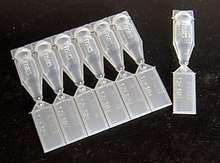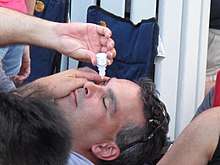Eye drop
Eye drops are saline-containing drops used as an ocular route to administer. Depending on the condition being treated, they may contain steroids, antihistamines, sympathomimetics, beta receptor blockers, parasympathomimetics, parasympatholytics, prostaglandins, nonsteroidal anti-inflammatory drugs (NSAIDs), antibiotics, antifungal, or topical anesthetics. Eye drops sometimes do not have medications in them and are only lubricating and tear-replacing solutions.

Eye drops have less of a risk of side effects than do oral medicines, and such risk can be minimized by occluding the lacrimal punctum, (i.e. pressing on the inner corner of the eye) for a short while after instilling drops. Eye drops are also used for stopping itching and redness of the eyes.
Prior to the development of single-use pre-loaded sterile plastic applicators, eye drops were administered using an eye dropper, a glass pipette with a rubber bulb.
Shelf life
Although most bottles of eye drops contain preservatives to inhibit contamination once opened, these will not prevent contamination indefinitely. Ophthamologists recommend disposing of bottles no longer than four weeks after opening.[1] Eye drops that contain no preservatives are usually packaged in single-use tubes. Dispensers typically oversize the drops; the human eye can only handle about 25 microlitres.[2]
Types and uses
Different pharmacological classes of eye drops can be recognized by patients by their different colored tops. For instance the tops to dilating drops are a different color than anti-allergy drops.
Rinse eye drops
Eyes drops sometimes do not have medications in them and are only lubricating and tear-replacing solutions.
Drug administration
Dry eyes
There is a wide variety of artificial tear eye drops that provide different surface healing strategies. One can find bicarbonate ions, hypotonicity, viscosity, and non-preserved types. They all act differently and therefore, one may have to try different artificial tears to find the one that works the best.[3]
Steroid and antibiotic eye drops
Steroid and antibiotic eye drops are used to treat eye infections. They also have prophylactic properties and are used to prevent infections after eye surgeries. They should be used for the entire time prescribed without interruptions. The infection may relapse if the use of the medication is stopped.[4]
Glaucoma
Eye drops used in managing glaucoma help the eye's fluid to drain better and decrease the amount of fluid made by the eye which decreases eye pressure. They are classified by their active ingredient and they include: prostaglandin analogs, beta blockers, alpha agonists, and carbonic anhydrase inhibitors. There are also combination drugs available for those patients who require more than one type of medication.[5]
Allergies
Some eye drops may contain histamine antagonists or nonsteroidal anti-inflammatory drug (NSAIDs), which suppress the optical mast cell responses to allergens including (but not limited to) aerosolized dust particles.
Pink eye
Antibiotic eye drops are prescribed when conjunctivitis is caused by bacteria but not when it is caused by a virus. In the case of allergic conjunctivitis, artificial tears can help dilute irritating allergens present in the tear film.[6]
Mydriatic eye drops
These make the eye's pupil widen to maximum, to let an optometrist have the best view inside the eyeball behind the iris. Afterwards in sunny weather they can cause dazzling and photophobia until the effect of the mydriatic has worn off.
In Russia, Tropicamide, a mydriatic eye drop, is used to some degree as an inexpensive recreational drug. Like other anticholinergics, when taken recreationally, tropicamide acts as a deliriant. According to one reporter, when injected intravenously, as is most often the case, the drug often "brings on suicidal feelings."
Injectable medication
Syringe designed saline drops (e.g. Wallace Cameron Ultra Saline Minipod) are distributed in modern needle-exchange programmes as they can be used efficiently either by injection or ophthalmic (if the drug is potent in small doses) route of administer which is compared to intravenous use; By demonstration, the elimination of latanoprost acid from plasma is rapid (half-life 17 minutes) after either ophthalmic or intravenous administration.[7]
Side effects

Steroid and antibiotic eye drops may cause stinging for one or two minutes when first used and if stinging continues, medical advice should be sought. Also, one should tell their doctor if vision changes occur or if they experience persistent sore throat, fever, easy bleeding or bruising when using drops with chloramphenicol. Also, one should be aware of symptoms of an allergic reaction, such as: rash, itching, swelling, dizziness, and trouble breathing.[4]
Prostaglandin analogs may cause changes in iris color and eyelid skin, growth of eyelashes, stinging, blurred vision, eye redness, itching, and burning. Beta blockers' side effects include low blood pressure, reduced pulse rate, fatigue, shortness of breath, and in rare occasions, reduced libido and depression. Alpha agonists can cause burning or stinging, fatigue, headache, drowsiness, dry mouth and nose, and also they have a higher likelihood of allergic reaction. Carbonic anhydrase inhibitors may cause stinging, burning, and eye discomfort.[8]
Lubricant eye drops may cause some side effects and one should consult a doctor if pain in the eye or changes in vision occur. Furthermore, when redness occurs but lasts more than 3 days, one should immediately consult a doctor.
See also
| Look up eye drop in Wiktionary, the free dictionary. |
| Wikimedia Commons has media related to Eye drops. |
- Artificial tears
- Carboxymethyl cellulose
- Mydriasis
- Refractive error
- Tetrahydrozoline hydrochloride
- Visine
References
- "Shelf-life of Eye Drops". American Academy of Ophthalmology. 10 March 2014. Retrieved 31 October 2016.
- Allen, Marshall (18 October 2017). "Drug Companies Make Eyedrops Too Big, And You Pay For The Waste". NPR. Retrieved 20 October 2017.
- Jayden, Wills (1 July 2010). "New breakthrough product to help put eye drops in". www.eyedrophelper.com. Retrieved 31 October 2016.
- "Generic Name: Steroid and Antibiotic Eye Drops". Retrieved 2010-05-03.
- "Glaucoma Medications and Their Side Effects". Retrieved 2010-05-03.
- "Pink Eye (Conjunctivitis) Treatments". Retrieved 2010-05-03.
- "Latanoprost Drug Information, Professional". Retrieved 18 September 2014.
- "Side Effects". Retrieved 2010-05-03.
-solution.jpg)

